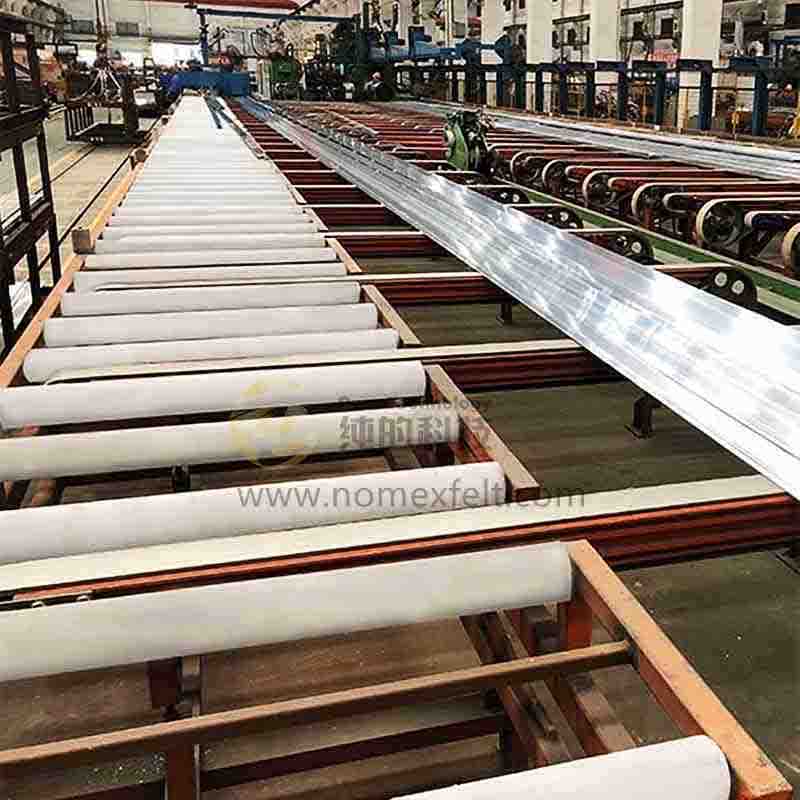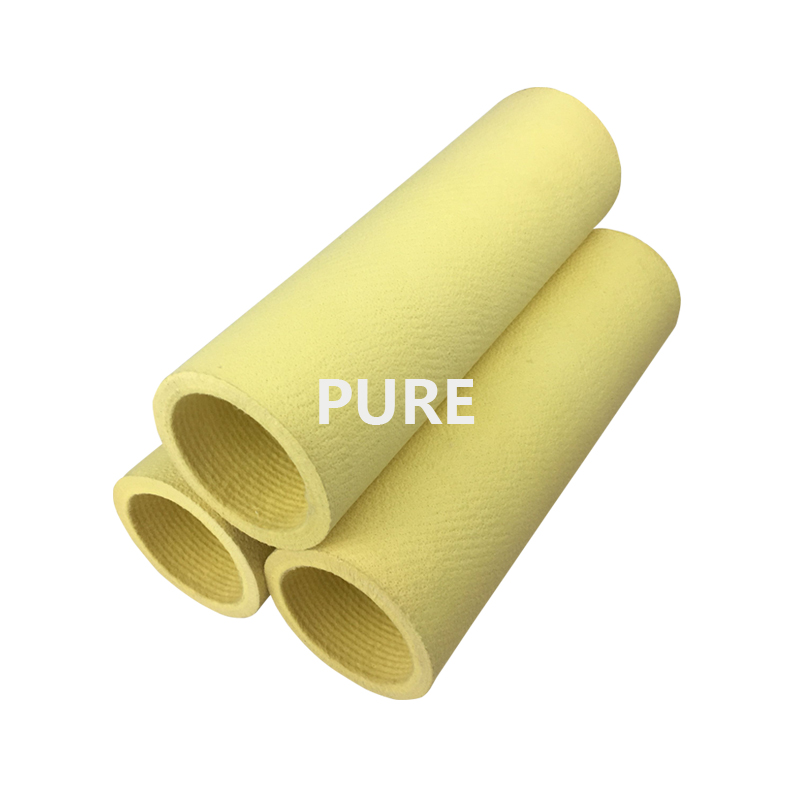Pretreatment
Before producing felt roller sleeves, the raw fiber needs to be pretreated to purify the fiber and remove impurities and pollutants. This usually includes steps such as soaking, washing, and bleaching.
Carding machine
The working principle of the carding machine is to open and comb the fiber.
Therefore, all the curled fiber blocks can be turned into straight single fibers.
At the same time, it can remove impurities and short fibers in the fiber.
In the final stage of carding, the needle-punching machine pierces the pure PBO fiber into a felt layer.
Needling
This is the core step of felt production. The needle-punching machine gradually compresses and consolidates the fiber layer to form a felt-like structure.
The needle punching machine inserts the needle into the fiber layer through the up and down movement of the needle needle, and then quickly rises up. So that the fibers in the fiber layer are interwoven with each other so that the fiber layer becomes solid and elastic.
The surface of the felt roller is smooth and clean, without a weaving pattern, which can provide good protection for the profile.
Cutting
The felt roller covers are made by cutting felt to fit and attaching it to the roller.
Some modern equipment can automate the cutting process, increasing efficiency and ensuring cutting quality.
Skilled craftsmanship ensures fast cutting and burr-free edges.
Inspection
Our work doesn’t end when production is finished.
Our professional-quality control staff will inspect all finished products using a variety of testing equipment.
Ensure that there are no broken needles in the feet and that all products meet specifications.
The problem of broken needles in felt roller covers usually refers to the situation in which, during the felt production process. The needle loom may cause the needles to break and remain in the felt material.

Quality problems during production: If damaged or defective needling equipment is used during the felt roller sleeve manufacturing process. It may cause the needles to break and remain in the felt.
Wear of needling equipment: Needling equipment that is used for a long time may wear out, making the needles more likely to break.
Improper operation: During the production process, improper operation, such as applying too much pressure or using improper tools, may also cause needles to break.
Design defects: If the design of the needling equipment does not match the production requirements of the conveyor roller sleeve. It may cause needles to break during the production process.
Accidental damage: If the felt roller sleeve is subjected to unexpected impact or pressure during transportation or storage. It may cause needles to break.
Damage during use: If the felt roller sleeve encounters hard or sharp objects during use, it may also cause needles to break.
To reduce the risk of broken needles in felt roller sleeves, FOSHAN PURE TECHNOLOGY CO., LTD.Ensures the use of high-quality raw materials and equipment, regular maintenance and inspection, and strict quality control processes.
Users must take precautions and strategies to deal with broken needles when using felt roller covers to ensure safety and product quality. Here are some recommended steps:
Choose a reputable supplier: Choose a reputable supplier when purchasing to ensure the quality and safety of the product.
Inspect the product carefully: Perform a thorough visual inspection of the felt roller cover before use to look for any possible broken needles or signs of damage.
Perform regular maintenance: Perform regular maintenance and inspection of the conveyor felt roller to prevent broken needles and other potential problems.
Use appropriate equipment: Make sure to use equipment suitable for the felt material to avoid broken needles caused by improper use of tools.
Employee training: Train operators to make them aware of the risks of broken needles and the correct operating methods.
Follow operating procedures: Make sure all operations are carried out following the manufacturer’s instruction manual and safety procedures.

Stop using immediately: Stop using the roller cover immediately if a broken needle is found to avoid further damage or injury.
Safely remove broken needles: Use professional tools or methods to safely remove broken needles from felt.
Isolate damaged roller sleeves: Isolate damaged roller sleeves from other products to avoid cross-contamination.
Notify supplier: Contact the supplier to report the problem and return or replace as needed.
Taking these measures helps reduce needle breakage risk in felt roller sleeves and ensures safety.
It can be seen that choosing a high-quality felt roller cover can better solve the above problems.
Our felt roller cover ⇓
The felt material is 100% pure, without any impurities. The higher the purity, the higher the quality. The heat-resistant temperature meets the requirements, wear-resistant, and the effective use time is longer than other manufacturers.
Advanced testing equipment ensures that the heat-resistant felt cover has no broken needle residue or hidden impurities. It will not leave any stains and dents on the aluminum profile.
There are four industrial-grade felts to choose from to meet customer needs.
With a complete range of molding equipment, our heat-resistant conveyor roller covers can be perfectly installed on the existing conveying system without any deviation.
 |
PBO Felt Roller Sleeve It is rated at 600°C and is a synthetic polymer that can withstand extremely high temperatures (while also having excellent chemical stability). If you have been looking for a heavy-duty Felt Roller Sleeve material that can withstand almost any pressure level, PBO Felt Roller Sleeve may be the ideal choice |
 |
Kevlar Felt Roller Sleeve With a temperature resistance of 500°C, this extremely durable, reliable, and trustworthy material is highly efficient, making it one of the most valuable choices for metalworking. Most notably, Kevlar is often seen on conveyor belts, which is a high-temperature area. |
 |
Nomex Felt Roller Sleeve With a temperature resistance of 280°C, Nomex is one of the most popular solutions in terms of roller cover materials, making it a great choice for your own aluminum profile fabrication work. In short, Nomex roller covers have excellent heat resistance and are also a relatively strong material. |
 |
Polyester Felt Roller Sleeve With a temperature resistance of 180C, polyester is a great alternative to some of the more expensive materials, especially for finishing areas at room temperature. Polyester is more cost-effective and has good long-term durability, and it is worth noting that polyester has a lower maximum temperature, which makes it best suited for finishing applications or medium-temperature environments. |
If you have any other questions or concerns, please contact us.
As we know, Heat Transfer Printing Felt is suitable for fabrics, decorative fabrics, curtains, le...
Read Safety Rules for Laundry Management to be a qualified manager. PARTⅠ Laundry room Safety Gen...
The extrusion machine is the leading equipment for the production of aluminum profiles. The quali...
Heat transfer printing is a contemporary printing process in the clothing market. It prints the p...
In the textile industry, felt is only a small part but important. About how to choose felt that i...
Foshan Pure Technology Company., Ltd. helps conveyor belt manufacturers source equipment to metal...
Nomex, an intermediate aramid, also known as aramid 1313. It is characterized by good heat resist...
In the 1960s, the Dupont developed a kind of aramid composite material, it is Kevlar. It has very...